9 Worst Bugs for Atlanta Lawns (and How to Get Rid of Them)
BY MELANIE JOSEPH | JUNE 25TH, 2019 | ATLANTA, GEORGIA, LAWN CARE, PESTS AND DISEASESAtlanta, known for its mild winters and humid summers, has a diverse ecosystem. But this also means that the city is home to a variety of bugs that can be a nuisance to homeowners. In fact, it’s the second “buggiest” city in the country, according to a recent study. From armyworms to white grubs, these lawn pests can invade yards and cause discomfort and health hazards.
Know how to deal with these pesky insects to keep your home and family safe. Take a closer look at the top 9 worst bugs for Atlanta lawns and learn tips on how to get rid of them.
In this article, we will cover:
- Why are Bugs Bad for Your Atlanta Lawn?
- Ways to Control Bugs on Your Atlanta Lawn
- 9 Worst Bugs in Atlanta
- Armyworms
- Billbugs
- Chinch Bugs
- Fire Ants
- Fleas
- Japanese Beetles
- Mole Crickets
- Spittlebugs
- White Grubs
Why are Bugs Bad for Your Atlanta Lawn?
Maintaining a lush, healthy lawn is a point of pride for many Atlanta homeowners. But the presence of bugs can quickly ruin your lawn’s appearance and damage its overall health. From destructive pests that eat away at your grass to disease-carrying insects that threaten both your lawn and your family’s well-being, the negative effects of bugs on your lawn cannot be overlooked.
Here are some of the reasons why bugs are bad for your Atlanta lawn:
- Bugs can destroy your lawn’s root system, making it more susceptible to environmental stressors and drought.
- Certain bugs, like grubs and chinch bugs, can eat away at the grass blades, leaving unsightly brown patches on your lawn.
- Bugs can attract other pests, like rodents, which can further damage your lawn and create additional problems.
- Some bugs, like fire ants, can pose a threat to your family’s health and safety.
- If your lawn is overrun with bugs, it makes it difficult to enjoy your outdoor space.
Ways to Control Bugs on Your Atlanta Lawn
A vibrant, pest-free lawn is essential to the beauty and enjoyment of your Atlanta property. However, with the warm and humid climate of the region comes a variety of bugs that can wreak havoc on your lawn’s health and appearance. Fortunately, there are two different ways of controlling bugs on your Atlanta lawn: organic methods and chemical treatments.
Organic Treatment Options
If you’re looking for a natural, chemical-free way to control bugs on your green lawn, several organic treatment options can effectively keep lawn pests at bay. Some of the most popular options that help control bugs without posing a risk to human and environmental health include:
- Beneficial nematodes: These tiny worms feed on pests like grubs, chinch bugs, and sod webworms.
- Diatomaceous earth: Made from fossilized remains of aquatic organisms, this fine powdery substance works by dehydrating pests like fleas, ticks, and ants.
- Heat treatment: Exposing the affected area to high temperatures can kill pests and their eggs.
- Neem oil: This natural oil, extracted from the seeds of the neem tree, is a potent insecticide that can repel a variety of pests, including ants, fleas, and chinch bugs.
- Pyrethrin: A natural insecticide derived from the chrysanthemum flower, it works by disrupting the nervous system of insects like fleas, mosquitoes, and ticks.
- Spinosad: Derived from the fermentation of a soil bacterium, it’s effective against various pests, including caterpillars, thrips, and mites.
Pest Control Chemical Treatments
While organic treatments are a great option for homeowners who prefer natural pest control methods, sometimes a more aggressive approach is necessary. Chemical treatments can effectively control pests, but you must use them carefully to avoid harming the environment or beneficial insects. Here are some common chemical treatments used for pest control:
- Bait: Effective for controlling pests like ants, cockroaches, and crickets, baits contain a poison that the pests consume and carry back to their colony, ultimately killing off the entire population.
- Fogging: This method of spraying a fine mist of insecticide is useful for controlling fleas, mosquitoes, and other flying insects that are difficult to target with other treatments.
- Insecticides: These chemicals designed to kill or repel insects come in various forms, including granular, liquid, and spray, and can be applied directly to the lawn or garden.
- Non-repellent pesticides: These are effective for controlling ants, termites, and other insects.
- Repellent pesticides: Useful for controlling mosquitoes and other flying insects, they work by creating a barrier around your lawn that pests will avoid.
- Systemic pesticides: These chemicals are absorbed by the plant and distributed throughout its tissues, making them toxic to insects like grubs, mole crickets, and Japanese beetles.
9 Worst Bugs for Atlanta Lawns
1. Armyworms (Spodoptera frugiperda)
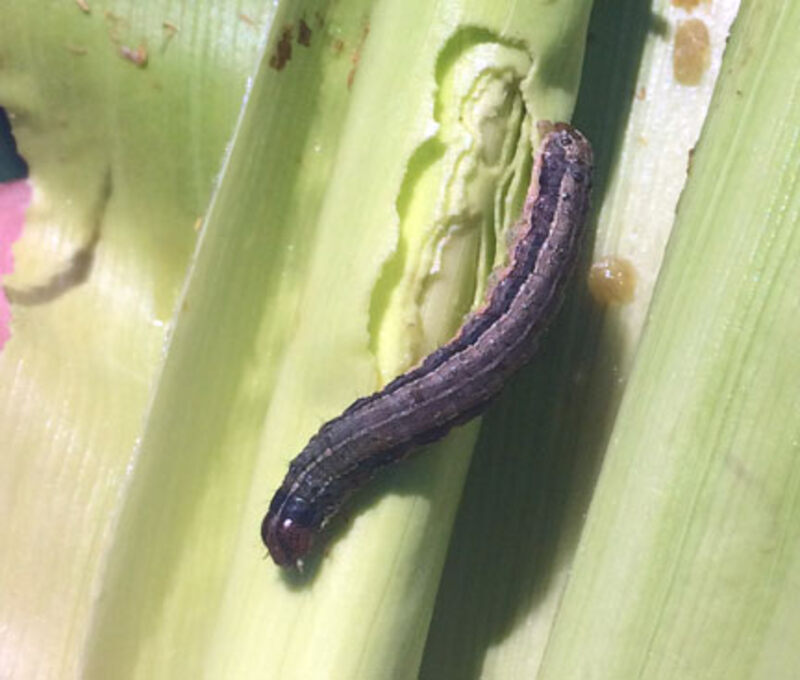
Photo Credit: K-State Research and Extension / Flickr / CC BY 2.0
What are Armyworms?
One of the worst bugs in the greater Atlanta area, armyworms cause significant damage to green lawns and fields. With their voracious appetites and ability to reproduce rapidly, armyworms can quickly decimate large areas of your lawn.
- They have a greenish-brown body and a series of white stripes running down their sides.
- Adult armyworms can reach up to 1.5 inches long, making them easy to spot in a lawn or field.
- They typically appear in late summer and early fall.
- Their growth cycle lasts between four and six weeks.
Signs of an Armyworm Problem
Signs they are in your lawn include areas of dead grass that appear brown or yellow and have been chewed down to the nub. These patches may appear quickly and grow larger over time. You also may see clusters of small, greenish-brown caterpillars congregating in patches of grass. Birds also start flocking to your property, as they are attracted to the armyworms as a food source.
How to Get Rid of Armyworms
To get rid of armyworms from your lawn, you can use chemical insecticides specifically designed to target these pests. Some effective options include pesticides containing pyrethroids or carbaryl. Remember to follow the instructions on the label carefully, as these chemicals can be harmful to humans, pets, beneficial insects, and other wildlife.
How to Prevent Armyworms
Preventing armyworms involves keeping lawns well-maintained and avoiding overfertilization.
Insect type: Caterpillar
Habitat: Grasses, including bermudagrass, perennial ryegrass, and Zoysiagrass
Danger: Moderate – while they don’t bite or transmit diseases, armyworms can quickly decimate large areas of vegetation and cause significant economic and environmental damage
Removal: Repellent and non-repellent pesticides, professional pest control services, or biological controls like nematodes or parasitic wasps
2. Billbugs (Sphenophorus spp.)
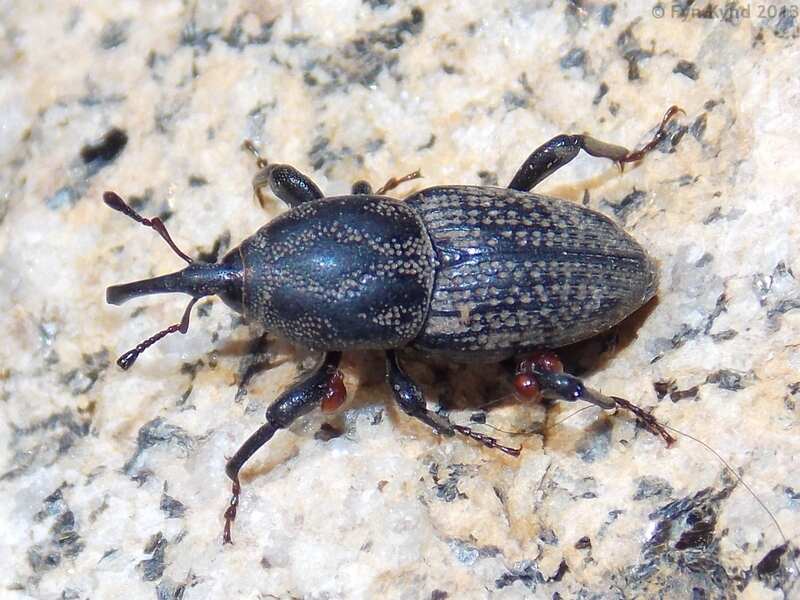
Photo Credit: Fyn Kynd / Flickr / CC BY 2.0
What are Billbugs?
Difficult to get rid of, billbugs can cause extensive damage to lawns, golf courses, sod fields, pastures, and other grassy areas in Atlanta. These small, beetle-like insects that can devastate grassroots and leave unsightly brown patches on once-lush lawns have the following characteristics:
- Most active in the spring and summer, billbugs prefer warm temperatures and abundant rainfall.
- With a distinctive long bill or snout, billbugs range from 1/4 to 1/2 inch long and are usually brown or black.
- Their entire life cycle takes about 60 to 90 days.
- They have short, stubby legs and two sets of wings but rarely fly. Instead, they crawl along the ground, causing the most damage to the grassroots.
Signs of a Billbug Problem
If you see signs of wilting or discoloration in your lawn, there’s a good chance billbugs are the culprit. You also may notice billbug larvae in the soil or on the surface of your lawn. Additionally, adult billbugs may be visible crawling on the grass blades.
How to Get Rid of Billbugs
Get rid of billbugs from your lawn by applying a pesticide specifically designed for these pests. You should keep your lawn healthy and mow it to the appropriate height.
How to Prevent Billbugs
Maintain healthy soil conditions, including proper drainage and aeration. Additionally, you can use insect-resistant grass varieties and avoid overfertilizing your lawn, as this can attract billbugs.
Insect type: Beetle
Habitat: Prefer to feed on warm-season grasses like bermudagrass, Zoysiagrass, and St. Augustinegrass
Danger: Moderate – billbugs do not transmit diseases to humans or pets, but their larvae can cause damage to lawns and grassy areas
Removal: Repellent and non-repellent pesticides can be used to control billbugs, but it’s important to follow the label instructions carefully and avoid overuse. In severe cases, professional pest control services may be necessary to eliminate the infestation.
3. Chinch Bugs (Blissus leucopterus)
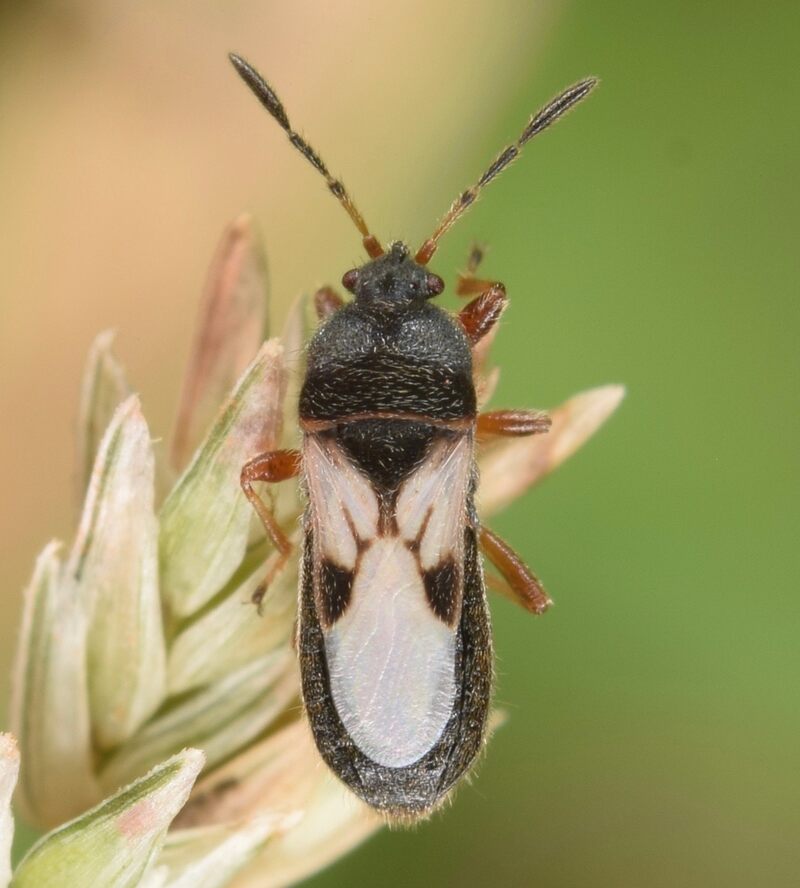
Photo Credit: Christina Butler / Wikimedia Commons / CC BY-SA 3.0
What are Chinch Bugs?
One of the most dreaded pests, these tiny bugs are responsible for causing massive damage to lawns by sucking the juices out of grass blades. Particularly worrisome in Atlanta due to the city’s hot and humid climate, chinch bugs have the following characteristics:
- About 1/6th of an inch long, these small insects have black bodies and white wings.
- These pests can produce multiple generations in a single year.
- They are often found in large groups on lawns, golf courses, and fields with hot and dry conditions, where they can quickly cause widespread damage.
- Chinch bugs typically appear in Atlanta lawns during the summer months – from June to August. They have a relatively short life cycle, with eggs hatching in just a few days and adult bugs emerging within a month.
- Additionally, they have a distinct odor that is often described as a “rotten” or “musty” smell.
Signs of a Chinch Bug Problem
If you notice certain areas of your lawn are turning yellow, it’s possible chinch bugs are to blame. These yellow or brown patches do not recover with watering.
You also may notice chinch bug nymphs and adults on the grass blades, soil surface, or in thatch. Try to inspect your lawn by parting the grass blades and looking for these tiny insects. Another way to check for chinch bugs is to use the coffee can method.
How to Get Rid of Chinch Bugs
To get rid of chinch bugs from your lawn, you can try applying a pesticide specifically designed for these pests. You should keep your lawn healthy by watering it regularly and mowing it to the appropriate height.
How to Prevent Chinch Bugs
Take steps to create an environment that is less hospitable to these pests. Ensure your soil has adequate drainage and is properly aerated. You can opt for grass varieties that are not prone to chinch bug infestations. Also, be mindful of how much fertilizer you use on your lawn, as overfertilization can create an ideal habitat for chinch bugs to thrive.
Insect type: Ground bug
Habitat: Prefer to feed on St. Augustinegrass but also can damage bermudagrass and Zoysiagrass
Danger: Low – these bugs don’t pose a health risk to humans and animals but may mistake human hair follicles for grass blades and bite them
Removal: Use insecticidal soap or pyrethrin-based insecticides, remove thatch buildup in lawns, increase soil moisture levels, and maintain proper lawn care practices to prevent infestations
4. Fire Ants (Solenopsis)
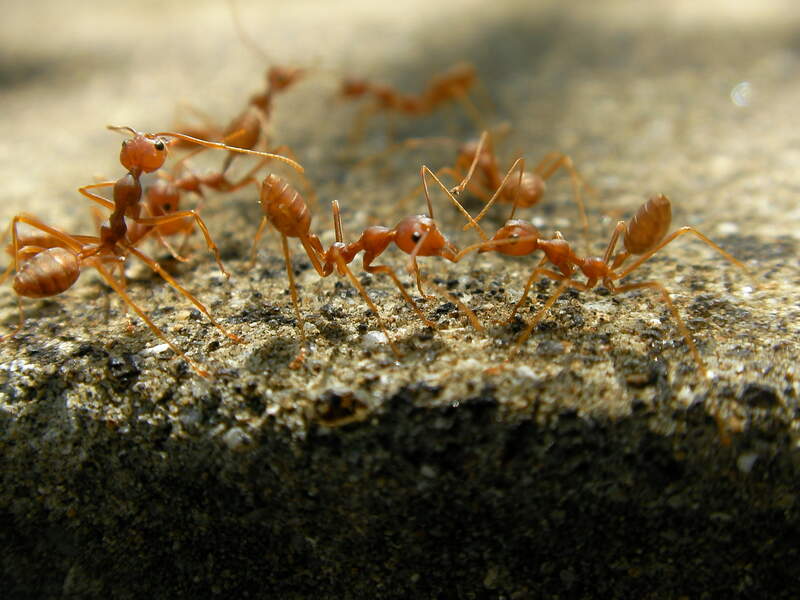
Photo Credit: Marufish / Flickr / CC BY-SA 2.0
What are Fire Ants?
Known to prefer warm, sunny areas like lawns, gardens, and parks, fire ants have a relatively short growth cycle, with new colonies being established through a process known as swarming. Once established, colonies can grow rapidly and can contain thousands of ants. These ants have the following characteristics:
- They typically appear in Atlanta in the late spring and early summer when temperatures begin to warm up.
- These reddish-brown ants are 1/16 to 1/4 inch long and have distinctive, segmented bodies.
- Fine hairs cover their bodies, and their heads are equipped with powerful mandibles that they use to capture and kill their prey.
- These tiny creatures can deliver a powerful sting that can cause swelling, severe pain, and even anaphylactic shock in some people.
- In addition to their painful bites, fire ants are notorious for their destructive nesting habits.
Signs of a Fire Ant Problem
One of the most obvious is the appearance of small, mounded nests in your yard. These nests can range in size from a few inches to several feet in diameter, and they are often found in sunny areas with loose soil. If you see a nest, be sure to approach it with caution, as disturbing it can cause the ants to become agitated and attack.
You also may notice swarms of ants crawling around your yard, particularly after rain, in the early morning or late afternoon hours.
How to Get Rid of Fire Ants
Don’t wait until you or a family member gets stung by fire ants. One effective method is to use a chemical insecticide specifically designed for fire ants. These products are typically applied directly to the ant mound and can provide long-lasting control.
Alternatively, you can use a natural remedy, such as pouring boiling water or a mixture of vinegar and baking soda onto the ant mound.
How to Prevent Fire Ants
Maintain a healthy lawn and remove potential nesting sites (piles of debris, tree stumps, and fallen logs) to prevent fire ants from invading your yard.
Insect type: Ant
Habitat: Prefer warm-season grasses like bermudagrass, St. Augustinegrass, and Zoysiagrass
Danger: Moderate to high – their bites can cause pain, swelling, and in some cases, anaphylactic shock
Removal: Use specialized fire ant bait or contact insecticide.
5. Fleas (Siphonaptera)

Photo Credit: Erturac / Wikimedia Commons / CC BY-SA 3.0
What are Fleas?
Fleas are notorious for their ability to cause intense itching and discomfort in both humans and animals. In addition to their irritating bites, they are also known to transmit a variety of diseases, making them a serious health risk. Other things you need to know about fleas include:
- Typically brown or reddish-brown in color, fleas are small, wingless insects around 1/12 to 1/6 inch long.
- Their flattened body is covered in spines and hairs, which helps them move through the fur or feathers of their hosts.
- Fleas have a relatively short life cycle, with females laying up to 50 eggs per day. The eggs hatch into larvae, which then spin a cocoon and pupate before emerging as adult fleas.
- Treating yards and lawns as breeding grounds, fleas are typically active year-round, but their activity may be reduced during the colder winter months.
Signs of a Flea Problem
Even though fleas are small and difficult to see, there are some signs that can indicate their presence. One of the most common signs is seeing your pets scratching and biting at their skin. You also may notice small, red bites on your pet’s skin (or even your own). Additionally, flea dirt (the waste products of fleas) can often be seen on the fur of pets or in infested areas.
How to Get Rid of Fleas
If the infestation is severe, professional pest control services may be necessary to eliminate the problem.
How to Prevent Fleas
Preventing flea infestations can be challenging, but grooming and bathing your pets regularly can help reduce their risk of flea infestations. Additionally, treating your pets with a preventative flea medication can provide long-lasting protection. Vacuuming your home regularly and washing your pets’ bedding in hot water also can help.
Insect type: Parasite
Habitat: Shady, humid, and moist areas of the lawn, but prefer to feed on the blood of warm-blooded animals such as cats, dogs, and rodents
Danger: Moderate to high – their bites can cause intense itching and discomfort, and they are known to transmit diseases like typhus and plague
Removal: Treat infested pets with a flea preventative medication, regularly groom and bathe pets, vacuum and wash pet bedding and other potentially infested areas, and seek professional pest control services if the infestation is severe
6. Japanese Beetles (Popillia japonica)
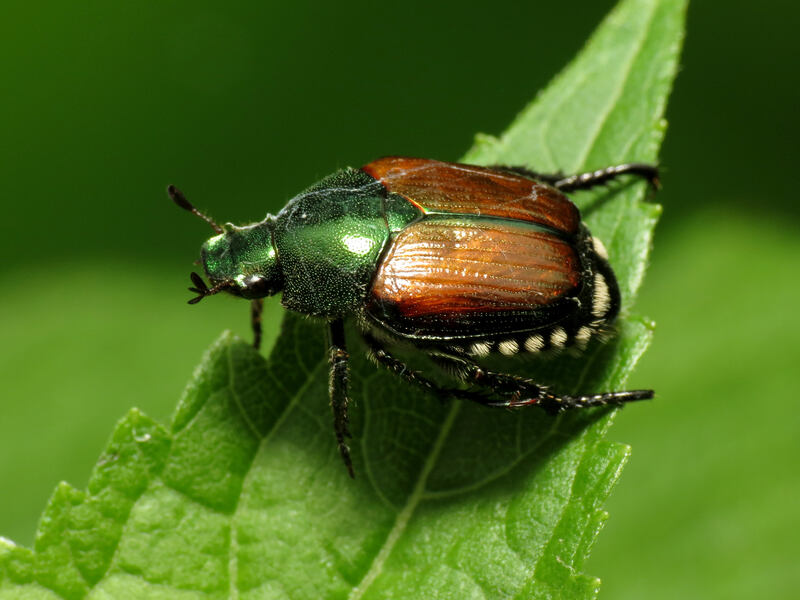
Photo Credit: Katja Schultz / Flickr / CC BY 2.0
What are Japanese Beetles?
A metallic green beetle with copper-colored wings, the Japanese beetle is one of Atlanta’s most destructive insect pests, causing significant damage to lawns, trees, shrubs, and other native plants.
- They are usually found in areas with moist soil.
- Japanese beetles typically appear in Atlanta in late June or early July, with the adult beetles remaining active for about six weeks.
- The life cycle of these beetles usually lasts for a year, with the eggs hatching into larvae (grubs) that feed on the roots of grasses before maturing into adult beetles.
- They are about 1/2 inch long and have six small tufts of white hair along their sides.
- Adult beetles feed on various plants’ leaves, flowers, and fruits, often consuming entire sections of foliage, leaving behind only the veins.
Signs of a Japanese Beetle Problem
It’s easy to identify Japanese beetles in your lawn, as they tend to gather in large groups. You also may notice small, circular holes in the leaves, which are a sign of their feeding.
How to Get Rid of Japanese Beetles
You can use physical barriers, like netting, to impede their access to your vulnerable lawn. In addition, applying insecticidal soap or neem oil on known feeding sites can effectively deter these pests.
Furthermore, manually removing adult beetles is a labor-intensive but effective method of control. For the grub stage of the beetle’s life cycle, you can apply a soil insecticide.
How to Prevent Japanese Beetles
Remove any rotting or decaying organic matter from your lawn to reduce the beetle population and eliminate potential breeding sites for the grubs.
Insect type: Beetle
Habitat: Kentucky bluegrass, tall fescue, Zoysiagrass, and bermudagrass are susceptible to Japanese beetle infestations.
Danger: Low – although they can cause skin irritation in some people
Removal: Use physical barriers like netting to prevent these beetles from reaching lawns, and insecticidal soap or neem oil on plants that they are known to feed on. Manually remove adult beetles and apply a soil insecticide to control the grub stage of the beetle’s life cycle.
7. Mole Crickets (Gryllotalpidae)
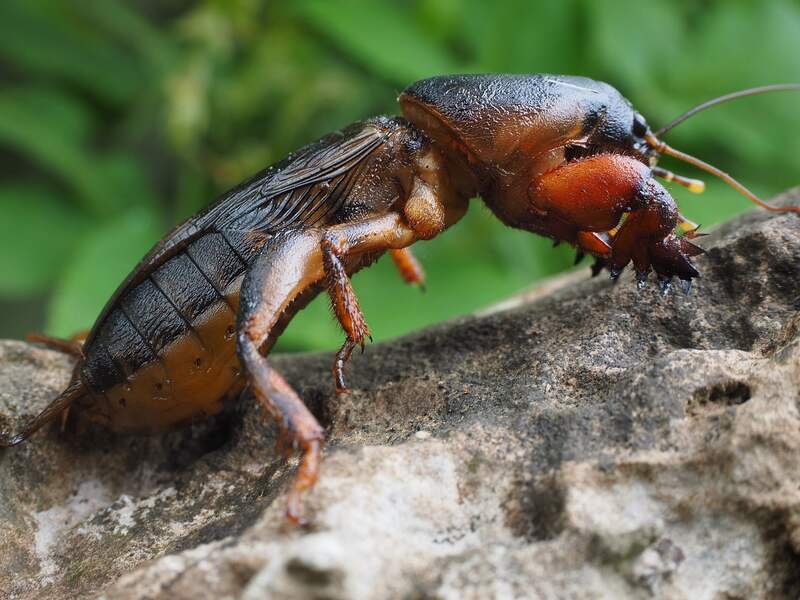
Photo Credit: pixabey
What are Mole Crickets?
Usually found underground, in soil and grassy areas, these small, cylindrical insects have destructive behaviors that can lead to significant economic losses for property owners in Atlanta.
- Typically brown or gray in color, mole crickets have large, powerful forelegs that they use to tunnel through the soil, giving them a distinctive appearance.
- They usually appear in the spring and summer.
- These crickets prefer warm temperatures and high moisture levels in the soil.
- Usually taking one to two years, the growth cycle of mole crickets includes several stages – egg, nymph, and adult. The eggs are usually laid in the fall and hatch in the spring. Then, the nymphs mature over the summer months and become adults in the fall.
Signs of a Mole Cricket Problem
One of the signs mole crickets are present in a lawn is the appearance of raised tunnels and mounds of soil. These tunnels can be several inches wide and extend several feet underground, causing considerable damage to the root systems of grasses and plants. Plus, patchy, brown spots on the lawn can be a result of the insects feeding on the grassroots.
How to Get Rid of Mole Crickets
You can use a pesticide specifically designed to target mole crickets. Look for a product that contains imidacloprid or bifenthrin – two active ingredients shown to be effective against mole crickets.
Another approach is to use biological control methods. Certain nematodes, like Steinernema scapterisci, are natural predators of mole crickets and can help reduce their population. You can purchase these nematodes online or at garden centers.
How to Prevent Mole Crickets
Watering your lawn less frequently and for longer periods of time can help create a less hospitable environment for mole crickets. Also, consider using physical barriers, like mesh screens, to prevent mole crickets from burrowing into your lawn.
Additionally, reducing outdoor lighting at night can help prevent mole crickets from being attracted to your yard.
Insect type: Cricket
Habitat: Mole crickets feed on various grass types, including bermudagrass, St. Augustinegrass, and centipedegrass.
Danger: Low – but their burrowing can cause damage to lawns and agricultural crops
Removal: Biological control (introducing natural predators) and chemical control (using insecticides)
8. Spittlebugs (Philaenus spumarius)
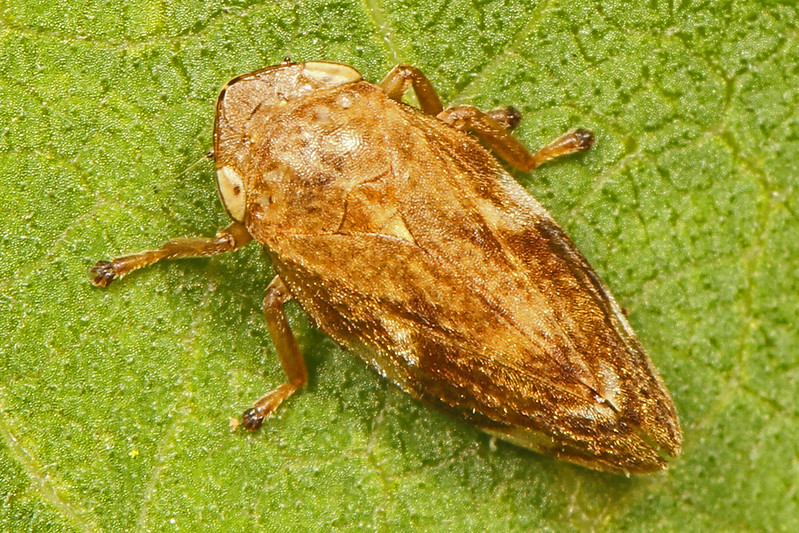
Photo Credit: Judy Gallagher / Flickr / CC BY 2.0
What are Spittlebugs?
Although not the most harmful pest, spittlebugs can be a nuisance for Atlanta homeowners with manicured lawns. These tiny insects have the following characteristics:
- They produce a frothy spittle-like substance that covers their bodies and protects them from predators and environmental factors.
- Also known as froghoppers, spittlebugs are small (about 1/4 inch long) and have a round or oval body shape.
- They are typically green or brown and have short, antennae-like appendages protruding from their heads.
- They prefer feeding on grass and plant stems, particularly in moist or humid areas.
- Spittlebugs undergo incomplete metamorphosis, with the nymphs developing into adults in about six weeks.
- They typically appear in the late spring and early summer when temperatures are mild.
- Adult spittlebugs can fly and mate, leading to the production of more eggs and the continuation of the life cycle.
Signs of a Spittlebug Problem
It’s relatively easy to spot spittlebugs in your lawn, as their frothy nests and foamy spittle are visible on the grass blades. Another sign of spittlebug damage is the yellowing or wilting of leaves.
How to Get Rid of Spittlebugs
Prompt treatment with insecticides or other control measures can help protect your lawn and prevent further damage. One effective method of control is the use of insecticidal soap or oil spray. These products work by suffocating the spittlebugs and disrupting their life cycle.
How to Prevent Spittlebugs
Homeowners can prevent spittlebug infestations by maintaining healthy lawns, removing excess thatch, and reducing excess moisture in the soil.
Insect type: Sucking insect
Habitat: While they feed on a wide range of plants, spittlebugs are particularly attracted to legumes and grasses like bermudagrass, Kentucky bluegrass, and fescue.
Danger: Low – but can cause mild skin irritation in some people
Removal: In most cases, spittlebugs do not require treatment as they do not cause significant damage to plants or grass. However, if a large infestation is present, an insecticidal soap or oil spray can be used to control the population.
9. White Grubs (Cyclocephala spp.)
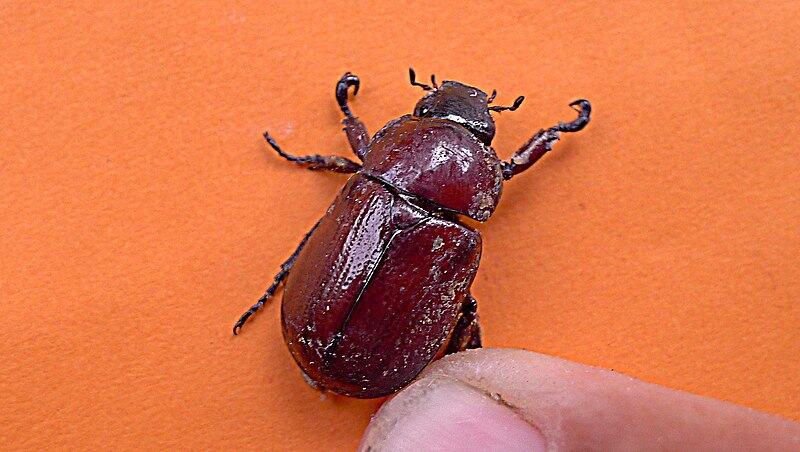
Photo Credit: Alex Popovkin / Wikimedia Commons / CC BY 2.0
What are White Grubs?
A common pest in lawns and gardens throughout Atlanta, white grubs are small, C-shaped larvae that can quickly devastate grass and other plants, feeding on the roots and causing them to wither and die.
- White grubs are the larval stage of various beetles, including Japanese beetles and June bugs.
- They can grow up to an inch long.
- Typically hatching in late summer or early fall, white grubs continue feeding on roots throughout the winter before pupating. In the spring, they emerge as adult beetles, mate, and lay eggs in the soil – starting the cycle anew.
- They have six legs near their head, which they use to crawl through the soil, and a small, dark head capsule.
- Their life cycle can take one to three years, depending on the species and environmental conditions.
Signs of a White Grub Problem
If you notice sections of your lawn turning brown and wilting, you may have a white grub infestation. You also may notice birds and other animals digging up your lawn in search of the grubs, as they are a common food source for many animals.
How to Get Rid of White Grubs
Gardeners and lawn enthusiasts may consider adopting a biological approach to control grubs in their soil. This approach involves introducing natural predators, like nematodes or parasitic wasps, that attack white grubs.
Chemical treatments can be highly effective but also can harm beneficial insects and pollinators, which are essential for the proper functioning of ecosystems. Therefore, you must follow the manufacturer’s instructions when using chemical treatments and only apply them as a last resort when other control methods have failed.
How to Prevent White Grubs
If left unchecked, white grubs can kill entire sections of turf. Maintaining a healthy lawn is an effective way to prevent white grub infestations. Use cultural control methods, like proper water, aeration, and regular lawn care to keep your lawn in top condition.
Insect type: Larva
Habitat: White grubs feed on the roots of many types of grass, including bermudagrass, bluegrass, fescue, and ryegrass.
Danger: Low – but can cause damage to turfgrass and other plants by feeding on their roots, leading to yellowing or browning of the grass and eventual death. They also attract predators like raccoons and skunks, which can cause further damage to lawns.
Removal: Biological control, such as introducing nematodes or parasitic wasps that attack the grubs. Chemical treatments are effective but should be used with caution as they can harm beneficial insects and pollinators.
FAQ About the Worst Bugs for Atlanta Lawns
Lawn bug infestations can have several long-term effects on your lawn, including: Weakened grass: Lawn bugs can damage the roots of your grass, making it weaker and more susceptible to other diseases, weeds, and environmental stressors. Brown spots: As lawn bugs feed on the grass, they can create brown spots and dead patches throughout your lawn. These spots can be unsightly and can take a long time to repair. Reduced growth: Infested lawns often grow more slowly than healthy lawns, leading to thinning grass. Increased vulnerability: A weakened lawn that bugs have damaged is more vulnerable to diseases, environmental stressors, and other pests. Costly repairs: If the infestation is not addressed promptly, it can result in costly repairs and replacement of damaged areas of your lawn. Address lawn bug infestations as soon as possible to prevent these long-term effects and keep your lawn healthy and beautiful.
Yes, there are certain times of the year when lawn bugs are more active in Atlanta. In general, they are more active during the warmer months when temperatures are consistently above 70°F. The peak activity of lawn bugs is typically from late spring through early fall, which is roughly from March to October. Some common lawn bugs in Atlanta, such as chinch bugs and white grubs, have two cycles of activity per year, with the first cycle occurring in the spring and the second in the late summer or early fall. This means that if you are dealing with an infestation of these bugs, it may require multiple treatments to eradicate them completely. Note: Even during the colder months, some lawn bugs can remain active and cause damage to your lawn. So stay vigilant and monitor your lawn for any signs of infestation throughout the year.
Follow these lawn maintenance practices to help prevent the growth and spread of lawn bugs: Proper watering: Overwatering your lawn can create ideal conditions for certain types of lawn bugs, like chinch bugs. Water your lawn deeply but infrequently, and allow the topsoil to dry out between watering. Regular mowing: Many lawn bugs prefer long grasses, so keep your lawn at the appropriate height for your grass type by regularly mowing it. Aerate your lawn: It can help reduce soil compaction, which can create an environment that is less favorable to lawn bugs. Remove thatch: Thatch buildup can create a breeding ground for lawn bugs. Regularly removing thatch can help prevent the growth and spread of lawn bugs. Use fertilizers responsibly: Over-fertilizing your lawn can create ideal conditions for lawn bugs. Always use fertilizers responsibly and follow the manufacturer’s instructions carefully.
Professional Pest Control for Your Atlanta Home and Landscape
Maintaining a beautiful and healthy lawn in Atlanta can be challenging, especially with the presence of pesky bugs. But with the right knowledge and techniques, you can keep these lawn pests at bay and enjoy a thriving lawn year-round.
By taking proactive measures, such as using chemical treatments, practicing proper lawn care, and consulting with experts when necessary, Atlanta homeowners can overcome the challenges of bug infestations and enjoy the benefits of a beautiful lawn.
Be vigilant and stay informed to keep your lawn healthy and pest-free. Contact an Atlanta pest control pro today.
Main Photo Credit: Tortoise beetle attacks bug / gbohne / Flickr / CC BY-SA 2.0